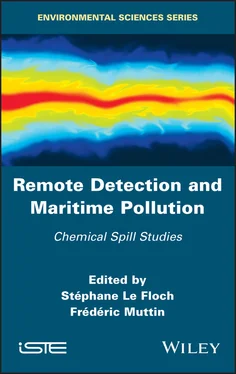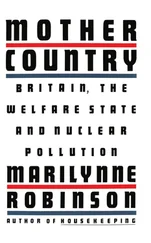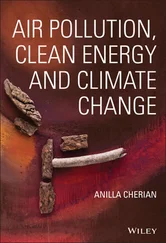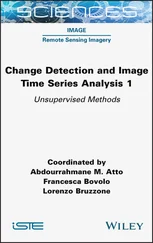Remote Detection and Maritime Pollution
Здесь есть возможность читать онлайн «Remote Detection and Maritime Pollution» — ознакомительный отрывок электронной книги совершенно бесплатно, а после прочтения отрывка купить полную версию. В некоторых случаях можно слушать аудио, скачать через торрент в формате fb2 и присутствует краткое содержание. Жанр: unrecognised, на английском языке. Описание произведения, (предисловие) а так же отзывы посетителей доступны на портале библиотеки ЛибКат.
- Название:Remote Detection and Maritime Pollution
- Автор:
- Жанр:
- Год:неизвестен
- ISBN:нет данных
- Рейтинг книги:5 / 5. Голосов: 1
-
Избранное:Добавить в избранное
- Отзывы:
-
Ваша оценка:
- 100
- 1
- 2
- 3
- 4
- 5
Remote Detection and Maritime Pollution: краткое содержание, описание и аннотация
Предлагаем к чтению аннотацию, описание, краткое содержание или предисловие (зависит от того, что написал сам автор книги «Remote Detection and Maritime Pollution»). Если вы не нашли необходимую информацию о книге — напишите в комментариях, мы постараемся отыскать её.
Remote Detection and Maritime Pollution — читать онлайн ознакомительный отрывок
Ниже представлен текст книги, разбитый по страницам. Система сохранения места последней прочитанной страницы, позволяет с удобством читать онлайн бесплатно книгу «Remote Detection and Maritime Pollution», без необходимости каждый раз заново искать на чём Вы остановились. Поставьте закладку, и сможете в любой момент перейти на страницу, на которой закончили чтение.
Интервал:
Закладка:
Rapeseed oil: rapeseed or colza oil is a vegetable oil obtained from crushed colza seeds. At ambient pressure and temperature, rapeseed oil is a viscous liquid with a specific gravity of 0.910. Rapeseed oil is insoluble in water and does not evaporate (vapor pressure below 0.01 kPa at 25°C); these characteristics classify rapeseed oil as a floater F in the SEBC.
FAME: fatty acid methyl esters are biofuel directly added to conventional fuels such as diesel. At ambient pressure and temperature, they are a liquid with a specific gravity of 0.888. This product is virtually insoluble in water (solubility of 0.023 mg.L −1at 20°C) and has a relatively low evaporative potential (vapor pressure of 0.42 kPa at 25°C) making it a floater F in the SEBC.
Toluene: toluene, also named methylbenzene or phenylmethane, is an aromatic hydrocarbon that is commonly used as a chemical reagent or solvent, particularly in the industrial sector. Toluene is a liquid at ambient pressure and temperature and has a specific gravity of 0.867. Toluene is nearly insoluble in water (535 mg.L −1at 25°C) and tends to evaporate relatively easily (vapor pressure of 2.91 kPa at 20°C). Considering the SEBC classification, toluene is a floating and evaporating (FE) substance.
Heptane: heptane is the generic term to identify one of the nine isomers of C 7H 16, and is a saturated hydrocarbon of the linear alkane family. This is a constituent of fuel and is used as an extraction solvent, a synthesis intermediate in the chemical industry and as a solvent for glues, inks, rubbers and plastics. At ambient pressure and temperature, heptane is a volatile liquid (6–7.7 kPa at 20°C) and nearly insoluble in water (< 2 mg.L −1at 20°C). With a specific gravity of 0.710, heptane is lighter than water and floats. According to the SEBC classification, heptane is considered as an evaporator E.
Xylene: xylene or dimethylbenzene is a group of aromatic hydrocarbons with one methyl derivative on benzene. It is naturally present in oil and can be observed in (diesel) engine exhaust gases, either as a residual oil chemical or formed during incomplete combustion. Xylene is also produced from oil in the petrochemical industry and is one of the 30 most produced chemicals in the USA. It is used in the printing, rubber and leather industries mainly as a solvent. Xylene is an inflammable liquid with a pleasant fragrance. Chemical properties are similar from one isomer to another. Its specific gravity of 0.87 makes it float on water. Xylene is slightly soluble in water (solubility below 20 mg.L −1at 20°C) and is not likely to evaporate (vapor pressure of 0.89 kPa at 20°C). Due to these characteristics, xylene is considered as an FE (floater and evaporator) in the SEBC classification.
Methanol: methyl alcohol or methanol is the simplest alcohol with the chemical formula CH 3OH. At ambient temperature, this polar liquid is used as antifreeze (for coolant, for example), solvent or fuel (in aeromodeling, for example). Methanol is not present in large amounts in nature and is industrially produced. It is mainly used as the basic material for chemical synthesis of more complex chemical products. Nearly 40% of methanol is converted into formaldehyde, which is then transformed into plastics, synthetic resins, paints, explosives or fabrics. Methanol is a light liquid (specific gravity of 0.791), volatile (vapor pressure of 12.3 kPa at 20°C), miscible in water, inflammable and toxic with a characteristic odor. These properties enable the classification of methanol as a DE (Dissolving and Evaporating) substance.
1.3. Experimental approach
The experimental approach is divided into two parts: first, the calibration of optical sensors on liquid pollutants in mesoscale experiments; second, airborne measurements of sea spills using hyperspectral optical and radar sensors.
1.3.1. Calibration of optical sensors
The calibration of optical measurements on liquid pollutants was realized in mesoscale (test-tank) experiments located at CEDRE (Brest) in October 2014. Three configurations were tested, with each one having specific objectives:
– vertical configuration: comparison between clean water and water covered by a chemical;
– horizontal configuration: detection of the gas cloud produced by the evaporation of the chemical;
– tank: evaluation of the influence of the slick thickness.
1.3.1.1. Vertical configuration
Eight different HNS (benzene, toluene, xylene, diethyl ether (DEE), rapeseed oil, propanol, methanol and heptane) were released into seawater inside a floating aluminum frame that was installed in the CEDRE pool, as presented in Figure 1.1. For each product, different spill volumes were used from 60 mL up to 5 L, and the seawater was thoroughly cleaned after each spill.
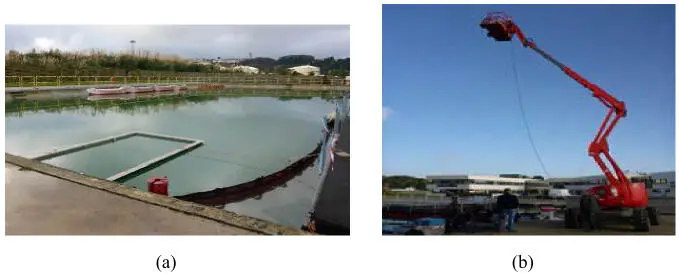
Figure 1.1. (a) Aluminum frame installed in the CEDRE pool. (b) Aerial lift with the three hyperspectral cameras
Three different hyperspectral imaging systems from 0.4 to 12 μm were used during this campaign: two reflective sensors (NEO HySpex cameras) from 0.4 to 1 μm (VNIR) and from 1 to 2.5 μm (SWIR) and a thermal longwave (LWIR) sensor from 8 to 12 μm (Telops Hypercam). Hyperspectral imaging cameras were deployed inside an aerial lift at a height of 12 m above the pool with a nadir-looking geometry and a Bomem MR300 spectroradiometer was placed next to the edge of the pool. The three sensors were pointed towards the expected center of the slick.
The aim was to evaluate how hyperspectral sensors can contribute to the detection of pollutants in a nadir-looking geometry.
1.3.1.2. Horizontal configuration
The sensors used for this configuration were as follows: two reflective sensors (NEO HySpex cameras) from 0.4 to 1 μm (VNIR) and from 1 to 2.5 μm (SWIR), an ASD Fieldspec camera from 0.4 to 2.5 µm, a thermal longwave (LWIR) sensor from 8 to 12 μm (Telops Hypercam), a Bomem MR300 spectroradiometer and a P-iCATSI (Polarized Improved Compact ATmospheric Sounding Interferometer).
Heptane, toluene, xylene, methanol, rapeseed oil, diethyl ether, silicone oil, unleaded gasoline and oil were released (volumes from 2 to 10 L). Diethyl ether and methanol were discharged directly in the basin, whereas the other products were released inside the floating aluminum frame.
Except for the interferometer, which was placed in an aerial lift several meters away from the basin, all the sensors were placed next to the edge of the pool.
1.3.1.3. Tank
The aim of this test was to qualify the impact of the thickness of the slick on the measured spectra. For this configuration, the Bomem MR300 spectroradiometer and the ASD Fieldspec camera were used. Heptane, xylene and rapeseed oil were released at the surface of a black-painted metallic barrel full of seawater.
The cloud coverage during the trial did not enable the realization of the initially planned measurements, and supplementary measures must be realized in the ONERA laboratory.
1.3.2. Evaluation of radar, optical and hyperspectral sensors at sea
1.3.2.1. General presentation of the experiment
The experimentation took place in May 2015 over the French coast in the Mediterranean Sea at two locations: 42°46.8’N/6°2.0’E for the first release and 42°45.5’N/5°48.5’E for the second and third releases. One cubic meter of each of the six chemical products (presented in section 1.2.2) was released at sea and imaged by radar and optical airborne sensors for their evaluation in real conditions.
Читать дальшеИнтервал:
Закладка:
Похожие книги на «Remote Detection and Maritime Pollution»
Представляем Вашему вниманию похожие книги на «Remote Detection and Maritime Pollution» списком для выбора. Мы отобрали схожую по названию и смыслу литературу в надежде предоставить читателям больше вариантов отыскать новые, интересные, ещё непрочитанные произведения.
Обсуждение, отзывы о книге «Remote Detection and Maritime Pollution» и просто собственные мнения читателей. Оставьте ваши комментарии, напишите, что Вы думаете о произведении, его смысле или главных героях. Укажите что конкретно понравилось, а что нет, и почему Вы так считаете.
